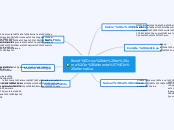Tempo Geológico
The Solar System is the gravitationally bound system of the Sun and the objects that orbit it, either directly or indirectly. Of the objects that orbit the Sun directly, the largest are the eight planets, with the remainder being smaller objects, the dwarf planets, and small Solar System bodies.
Cenezoica
Mars is a cold, desert-like place covered in dust. This dust is made of iron oxides, giving the planet its iconic red hue.
Mars shares similarities with Earth: It is rocky, has mountains, valleys and canyons, and storm systems ranging from localized tornado-like dust devils to planet-engulfing dust storms.
Quartenário
Mars has two small moons.
Name these moons.
Estabilização das placas tectônicas
Clima tropical
Aparecimento da espécie humana moderna
Surgimento da civilização humana
Neogeno
A planet's day is the time it takes the planet to rotate or spin once on its axis.
Write down Mars's day measured in Earth days.
Fauna mais semelhante com a atual
Expansão do oceano
Aparecimento do Homo Sapiens
Paleogeno
Conhecida como era dos mamíferos
Plantas modernas
Diversificação de formas de vida na fauna e flora
Primeiros primatas
Expansão das aves
Earth is a water world, with two-thirds of the planet covered by oceans.
It's the only world known to harbor life.
Earth's atmosphere is rich in nitrogen and oxygen.
Its name originates from 'Die Erde,' the German word for 'the ground.'
Earth may once have had two moons, nowadays it has just one.
Mesozoica
A planet's day is the time it takes the planet to rotate or spin once on its axis.
Write down the Earth's day in hours.
Extinção dos dinossauros
Surgem tubarões, peixes ósseos e crocodilos marinhos
A terra se encontra coberta com árvores e flores
Surgem répteis como tartarugas
Surgimento dos primeiros mamíferos
Era dos dinossauros
Clima árido e quente
Fanerozoico
Venus is Earth's twin in size and has no moons.
Its surface has various mountains and volcanoes. Because of its thick, toxic atmosphere that's made of sulfuric acid clouds, Venus is an extreme example of the greenhouse effect. The average temperature on Venus' surface is 900 F (465 C).
Venus spins slowly from east to west, the opposite direction to most of the other planets.
The Greeks believed Venus was two different objects — one in the morning sky and another in the evening. Because it is often brighter than any other object in the sky, Venus has generated many UFO reports.
Paleozoica
A planet's day is the time it takes the planet to rotate or spin once on its axis.
Write down Venus's day measured in Earth days.
Aparecimento da maioria dos filos existentes atualmente
Surgimento de grandes florestas
Aparecimento de insetos
Animais marinhos
Anfíbios
Répteis
Animais com exoesqueleto
Diversificação da vida
Pangeia
Surgem animais com partes minerais
Pré-cambriano
Mercury is the smallest, only a little bit larger than Earth's moon. Mercury has no moon.
It experiences dramatic changes in its day and night temperatures: Day temperatures can reach a scorching 840 F (450 C), which is hot enough to melt lead. Meanwhile, on the night side, temperatures drop to minus 290 F (minus 180 C).
It also has a very thin atmosphere of oxygen, sodium, hydrogen, helium, and potassium and can't break-up incoming meteors, so its surface is pockmarked with craters, just like the moon.
Neoproterozoica
Diversificação de seres
Mesoproterozoica
Primeiros seres multicelulares
Proliferação dos seres fotossintetizantes
Paleoproterozoica
How long does it take for Mercury to go around the sun?
Aparecimento dos primeiros animais e vegetais
Algas coloniais e invertebrados de corpo mole
Arqueano
A planet's day is the time it takes the planet to rotate or spin once on its axis.
Write down Mercury's day measured in Earth days.
Aparecimento das primeiras células
Organismos unicelulares
Hadeano
Our Solar System has eight “official” planets which orbit the Sun.
Each planet is at a different distance from the sun. Name its position.
Início da vida na terra
Aumento da liberação de gás oxigênio para a atmosfera









